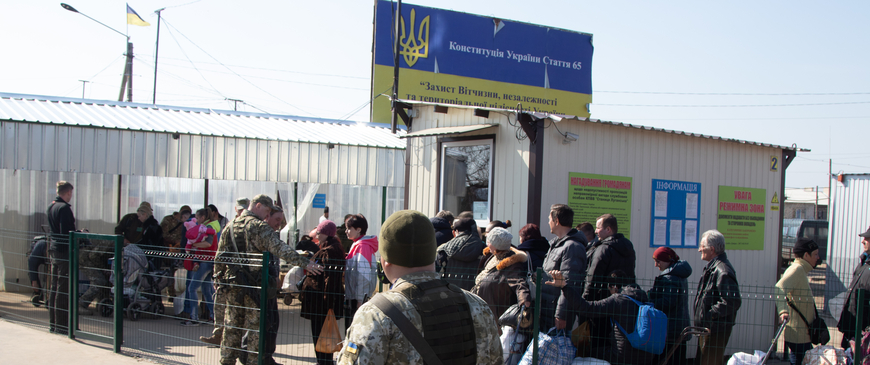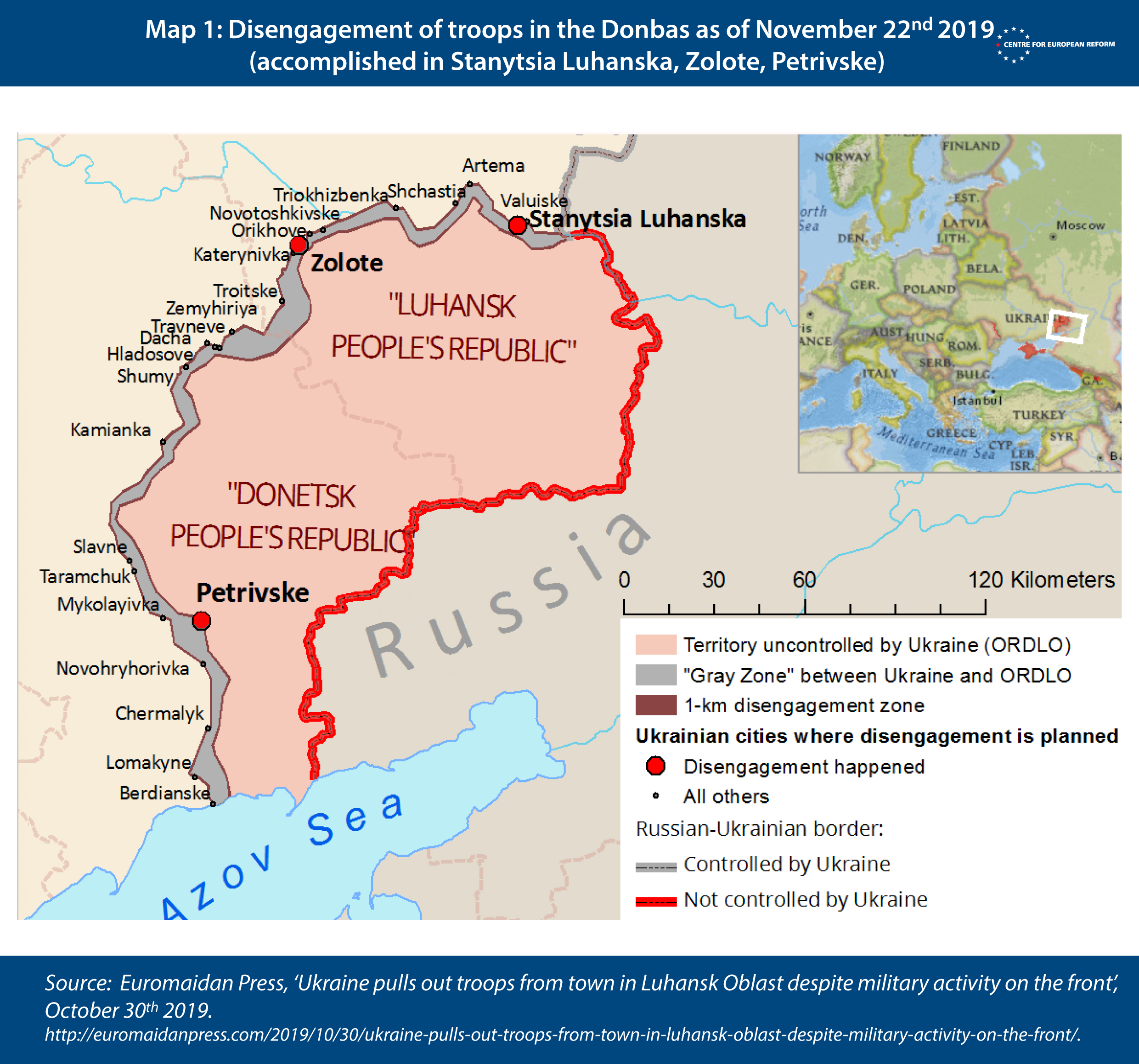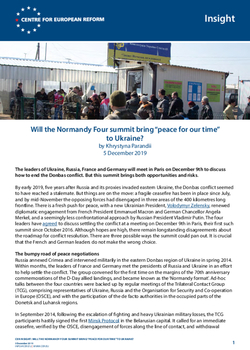
Will the Normandy Four summit bring "peace for our time" to Ukraine?
The leaders of Ukraine, Russia, France and Germany will meet in Paris on December 9th to discuss how to end the Donbas conflict. But this summit brings both opportunities and risks.
By early 2019, five years after Russia and its proxies invaded eastern Ukraine, the Donbas conflict seemed to have reached a stalemate. But things are on the move: a fragile ceasefire has been in place since July, and by mid-November the opposing forces had disengaged in three areas of the 400 kilometres long frontline. There is a fresh push for peace, with a new Ukrainian President, Volodymyr Zelensky, renewed diplomatic engagement from French President Emmanuel Macron and German Chancellor Angela Merkel, and a seemingly less confrontational approach by Russian President Vladimir Putin. The four leaders have agreed to discuss settling the conflict at a meeting on December 9th in Paris – their first such summit since October 2016. Although hopes are high, there remain longstanding disagreements about the roadmap for conflict resolution. There are three possible ways the summit could pan out. It is crucial that the French and German leaders do not make the wrong choice.
The Paris summit of the Normandy Four follows the troop withdrawal of Ukrainian and Russia-backed forces in three areas along the 400 km long line of contact.
The bumpy road of peace negotiations
Russia annexed Crimea and intervened militarily in the eastern Donbas region of Ukraine in spring 2014. Within months, the leaders of France and Germany met the presidents of Russia and Ukraine in an effort to help settle the conflict. The group convened for the first time on the margins of the 70th anniversary commemorations of the D-Day allied landings, and became known as the ‘Normandy format’. Ad-hoc talks between the four countries were backed up by regular meetings of the Trilateral Contact Group (TCG), comprising representatives of Ukraine, Russia and the Organisation for Security and Co-operation in Europe (OSCE), and with the participation of the de facto authorities in the occupied parts of the Donetsk and Luhansk regions.
In September 2014, following the escalation of fighting and heavy Ukrainian military losses, the TCG participants hastily signed the first Minsk Protocol in the Belarusian capital. It called for an immediate ceasefire, verified by the OSCE, disengagement of forces along the line of contact, and withdrawal of illegal armed formations from Ukraine’s territory. Ukraine agreed to introduce legislation granting amnesty to supporters of separatist regimes. It also agreed to grant ‘special status’ to the occupied territories, giving them greater autonomy in relation to local law enforcement and judicial bodies, and the use of the Russian language, as well as increased state support for the region’s social and economic development. The agreement also prescribed early local elections in the contested regions. But from the outset, Ukraine and Russia disagreed over the sequencing of the different steps.
After renewed fighting, the Normandy format leaders negotiated a new ‘Package of measures for the Implementation of the Minsk agreements’ (known as Minsk-2) in February 2015. Though Minsk-2 reduced fighting, none of its 13 points has been fully implemented. Two issues in the peace talks became particularly contentious: on the military side, the disengagement of forces; and on the political side, the arrangements for local elections.
In 2016, the TCG attempted to tackle the military issue by defining three pilot disengagement areas (Stanytsia Luhanska and Zolote in the Luhansk region, and Petrivske in the Donetsk region). Meanwhile, on the political side, then German Foreign Minister Frank-Walter Steinmeier proposed a formula whereby Ukraine would grant special status to the occupied territories once local elections had taken place there and been recognised by the OSCE. But Ukraine and Russia’s views on the political settlement remained at odds. Ukraine insisted that occupied territories needed to be returned to its control before elections could be held in them, while Russia pressed for election of new local authorities before any further steps in the peace process. The impasse within the Normandy group ensured the peace talks remained in limbo until summer 2019.
New momentum for the peace process – and enduring risks
Hopes for peace were raised in 2019 with the election of Zelensky, who had promised to fight corruption and end the conflict, which has claimed 13,000 lives and left another 30,000 wounded. At Zelensky’s initiative, foreign policy advisors of the Normandy leaders resumed talks, providing impetus to the TCG negotiations in Minsk. The first tangible result was a new ceasefire, starting on July 21st 2019. Although there have been numerous violations, and over 20 Ukrainian soldiers have since been killed, civilian casualties have fallen significantly and the OSCE still regards the ceasefire as holding. Another breakthrough occurred with the disengagement of forces in Stanytsia-Luhanska and improvements in the humanitarian situation on the ground. Moreover, in August, Zelensky and Putin agreed on a much anticipated prisoner swap. These developments have breathed new life into the peace process, and prompted Zelensky to call for a new summit of the Normandy leaders.
In response, Russia said the summit could go ahead only if the disengagement was completed in all three pilot areas and if Ukraine accepted the ‘Steinmeier formula’. Putin may have calculated that Zelensky would reject these terms, in the face of significant domestic opposition. But on October 1st Ukraine agreed on the text of the formula, pledging to implement the law on special status for the occupied territories in Donbas on condition that the OSCE’s Office for Democratic Institutions and Human Rights (ODIHR) certified that local elections there complied with international standards and Ukrainian legislation. The formula is just one element of a potential conflict settlement plan, as the parties in the TCG have not yet agreed on the conditions for calling and holding local elections. However, the de facto authorities in Donbas portrayed this agreement as Ukraine’s unconditional acceptance of their autonomy, fuelling resentment among the wider Ukrainian population. Zelensky’s decision to agree to the two Russian preconditions for the summit triggered protests by thousands of Ukrainians across the political spectrum.

Ukrainians are worried that Zelensky will make unacceptable compromises. Recent surveys show that the majority of Ukrainians would oppose holding local elections while the territories in question remain under Russian control. As long as Ukrainian state institutions are barred from operating in the area and no genuine democratic campaigning can take place, the outcome of the elections would be a foregone conclusion and the de facto authorities would stay in power. Furthermore, even a very limited disengagement of forces is problematic, as it leaves some towns and villages unprotected in a grey area, over which neither side exerts military control.
In an attempt to reassure Ukrainians, Zelensky has repeatedly declared that Russia must withdraw from Donbas, and Ukraine should regain control of its borders, before elections can take place and the special status for the occupied territories can come into force. However, these steps need to be spelled out in detail, as the Minsk agreements are ambiguous.
An updated and more detailed framework for settling the conflict is needed – a ‘Minsk-3’ – and the Paris summit may present an opportunity to conclude one. By accepting the domestically controversial preconditions for the meeting, Zelensky has demonstrated that Ukraine is ready to move forward, and challenged Russia to do its part. But he must now ensure that the Normandy partners accept Ukraine’s vision for conflict resolution, which starts with restoring its sovereignty and territorial integrity.
The Normandy summit may present an opportunity to conclude an updated and more detailed framework for conflict resolution in Donbas ('Minsk-3'). As peace brokers, France and Germany should insist that it starts with restoring Ukraine’s sovereignty and territorial integrity.
What is at stake at the Normandy summit?
Besides the EU’s strategic interest in having one of its largest neighbours stable and prosperous, both the French and German leaders have a personal interest in resolving the conflict in eastern Ukraine. Macron has embarked on a solo mission to improve relations between the EU and the Kremlin, but this ambition sits uneasily with Russia’s continued aggression in Ukraine. For Merkel, who is planning to retire after the 2021 federal elections, securing peace in Ukraine, while maintaining a principled German (and EU) position towards Putin, would represent a major achievement on the international stage before she steps down.
There are three likely scenarios for the Normandy summit:
- an agreement on the basis for a comprehensive roadmap for conflict resolution (‘Minsk-3’), where the key issues are settled;
- progress on some reconciliatory 'small steps', leaving talks on the conflict settlement open-ended, with further new agreements potentially to follow at later summits (if any);
- a rushed agreement on a political settlement, without the verified withdrawal of Russia-backed forces.
Neither Macron nor Merkel will want the December 9th meeting to end in failure. They may therefore be tempted to go for the second option, and pick the low-hanging fruits. These may include Russia agreeing to release the remaining Ukrainian political prisoners, meet Ukraine’s demands in the talks on a new gas transit contract, or returning assets from the occupied territories. Though this half-way house scenario would be better than nothing, feel-good measures with no strategic significance are unlikely to do much to resolve the conflict.
Macron and Merkel should instead push for an upgrade of the Minsk agreements, which would set out a clear sequence and timetable for implementation. And crucially, the West should not lift sanctions or re-engage politically with Russia (including in the G7/G8 format), until Moscow has met its side of the bargain.
A meaningful Minsk-3 agreement should incorporate two key points. First, France and Germany should explicitly state, and press Russia to accept, that elections in the occupied territories cannot be held until Ukraine regains control over the full length of its border and illegal armed groups are disarmed. Proceeding with a political settlement without these security measures would be the worst outcome.
Secondly, the Normandy parties will need to agree which international organisations should be involved in administering the temporarily occupied areas for the transitional period, until local elections have taken place and the Ukrainian state institutions are fully reinstated. This task cannot be assigned to the illegal quasi-state structures of the self-proclaimed 'People’s Republics', which will need to be dismantled as the territories return to Ukrainian control (albeit with some autonomy).
Agreement to proceed with a political settlement of the Donbas conflict without restoration of Ukraine’s border with Russia and disarmament of illegal armed groups would be the worst outcome of the Normandy leaders' talks. France and Germany shall not make this mistake.
On a practical level, verifying that the security provisions of the Minsk agreements have been met will require more observers, able to carry out their mandate throughout the occupied territories, including along the Russia-Ukraine border. The OSCE Special Monitoring Mission (SMM) currently has around 700 monitors, but thousands more would be needed to cover an area of around 20,000 square kilometres. France and Germany should signal their support for a potential expansion of both the mandate and scope of the OSCE SMM that would need to monitor not only the withdrawal of forces, but also disarmament of illegal formations.
The West also needs to be ready to deter any Russian moves to stoke tensions in the east. Russia has recently given 170,000 Donbas residents Russian citizenship; this is reminiscent of what Russia did in the Abkhazian and South Ossetian regions of Georgia to justify its 2008 military intervention there. EU member-states should follow the EU’s guidance on non-recognition of such passports, while the Normandy leaders should address this issue during the summit. Macron and Merkel should also make clear that they would back additional sanctions if Russia tried to destabilise the Azov Sea region further by blocking Ukraine’s access to its waters and ports.
And finally, despite their focus on the Donbas peace negotiations, Western leaders should not forget the annexation of Crimea. They should continue to reject Russia’s claim to Crimea and maintain all the related sanctions.
Donbas is not a lost cause, but the longer the conflict lasts, the harder it will be to resolve. The fundamental obstacle to peace is Putin’s determination to keep Ukraine destabilised to hamper its aspirations to join the EU and NATO. The ongoing instability also prevents Russians from seeing Ukraine as an example of a successful post-Soviet democracy. As a result, counting on Putin’s goodwill to resolve the conflict is pointless. But economic sanctions continue to provide Western leaders with leverage. The combination of Russia’s low growth rate and the growing domestic demand for change may prompt Putin to make some concessions in Donbas. Russians are not as attached to Donbas as they are to Crimea, so Putin’s popularity may not suffer if he softens his policy on Donbas. Macron and Merkel should remember that Russia has been the aggressor since 2014, and resist the temptation to press Zelensky into unacceptable compromises, because he is in a weaker position than Putin.
History will not judge the leaders of France and Germany kindly if, like the British Prime Minister Neville Chamberlain in 1938, they proudly declare “peace for our time”, only for Russia to advance further in Ukraine. A flawed agreement would be a step backward on the road to lasting peace.
Khrystyna Parandii is the Clara Marina O'Donnell Fellow (2019-2020) at the Centre for European Reform.


Add new comment